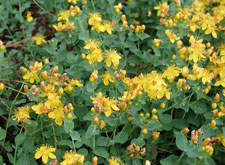Resource Library
Plant of the Week: St. John's Wort
The University of Arkansas System Division of Agriculture does not promote, support or recommend plants featured in "Plant of the Week." Please consult your local Extension office for plants suitable for your region.
Plant of the Week
St. John's Wort
Latin: Hypericum perforatum

We Americans live pretty much in cocoons; isolated inside our air-conditioned homes, cars and office buildings. Food magically appears in the produce aisles, and drugs spill out of pill bottles. But that has not always been the way we lived. Plants such as St. John's Wort (Hypericum perforatum) have long been used in human medicine and have, after a long absence, reappeared in our lives.
Hypericums are a diverse group of almost 400 species of twiggy herbaceous and woody shrubs scattered throughout the northern hemisphere. Once assigned to their own family, they're now classified as members of the tropical mangosteen family (Clusiaceae). Common St. John's Wort is native to Europe but has become established as a rangeland weed across most of the United States.
Common St. John's Wort is an herbaceous perennial growing about 2 feet tall and slowly spreading by underground stems. It has reddish-brown stems and opposite, elliptical leaves that are marked with translucent dots if you hold them up to the light.
Bright yellow flowers appear in terminal clusters in mid-summer. Individual blooms are ¾-inch across with five petals and lots of stamens making the flowers an easy way to identify almost any Hypericum. Following flowering teardrop shaped seed capsules form that produce lots of seeds.
St. John's Wort gets its name from celebrations dating back to pre-Christian days when a midsummer festival was held on the longest day of the year throughout much of Europe on June 23 or 24. The plant was in bloom at that time and flowers were picked and placed above images and shrines to ward off evil spirits and witches. After Christianity spread, the festival was converted to St. John's Feast and is still celebrated in many countries.
Gerard's 1633 herbal gives a number of medicinal uses for the plant and detailed instructions for extracting the active ingredients from the leaves, twigs and seeds using olive oil and wine. This concoction was used primarily to treat flesh wounds, "rotten or filthy ulcers" or for helping pass kidney stones. Native Americans also used Hypericum to treat wounds.
Modern medicine recognizes that one component of the plant extract - hyperforin - is a strong antibiotic effective against drug resistant forms of Staphyloccus.
But most of us know of St. John's Wort as a treatment for mild to moderate depression. In several compiled studies comparing St. John's Wort to placebo and one chemical antidepressant, the herbal remedy worked as effectively as the antidepressant but had fewer side effects.
In a National Institute of Health study involving 340 patients, it was ineffective for mild to severe depression, but the chemical antidepressant was also ineffective. While generally well tolerated, some individuals experience side effects from the plant.
A number of Hypericums are grown in the garden as ornamentals. Generally speaking they do better in sunny, cool, moist areas and suffer in the heat of summer. In hot areas of the country, they tend to be short lived, whereas in cooler locales they prosper and can even become weedy.
Favorites include Shrubby St. John's Wort (H. prolificum), a 5-foot tall rounded deciduous shrub; Goldencup St. John's Wort (H. patulum), which is used as a semi-evergreen sprawling groundcover; and H. x moeranum 'Tricolor,' a beautiful, variegated spreader with rose and white leaves.
By: Gerald Klingaman, retired
Extension Horticulturist - Ornamentals
Extension News - July 6, 2007
The University of Arkansas System Division of Agriculture does not maintain lists of retail outlets where these plants can be purchased. Please check your local nursery or other retail outlets to ask about the availability of these plants for your growing area.